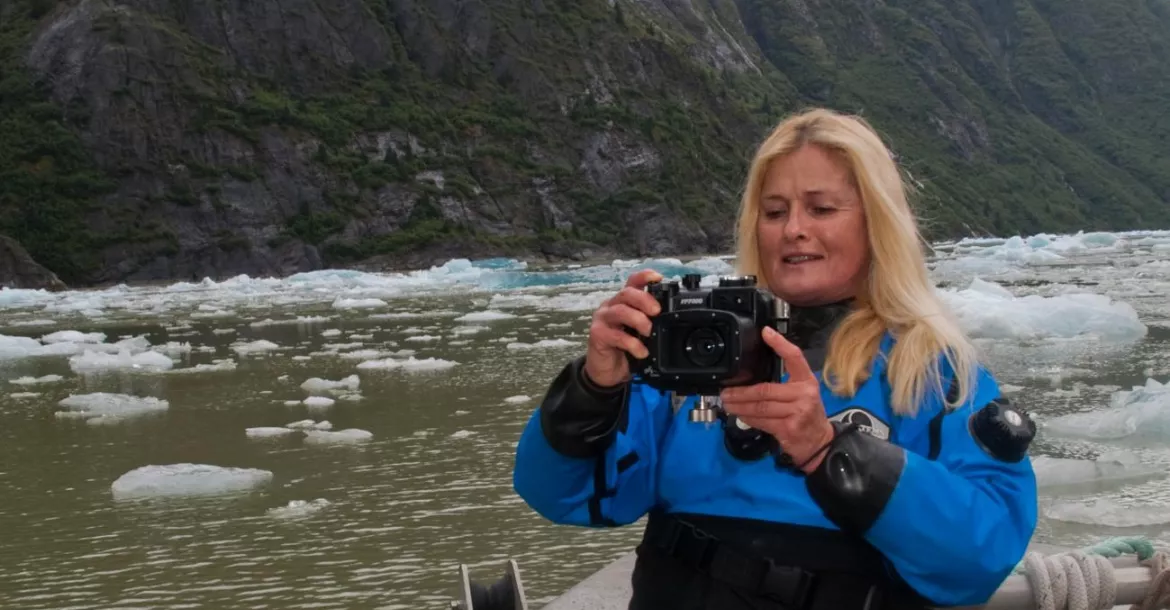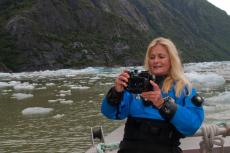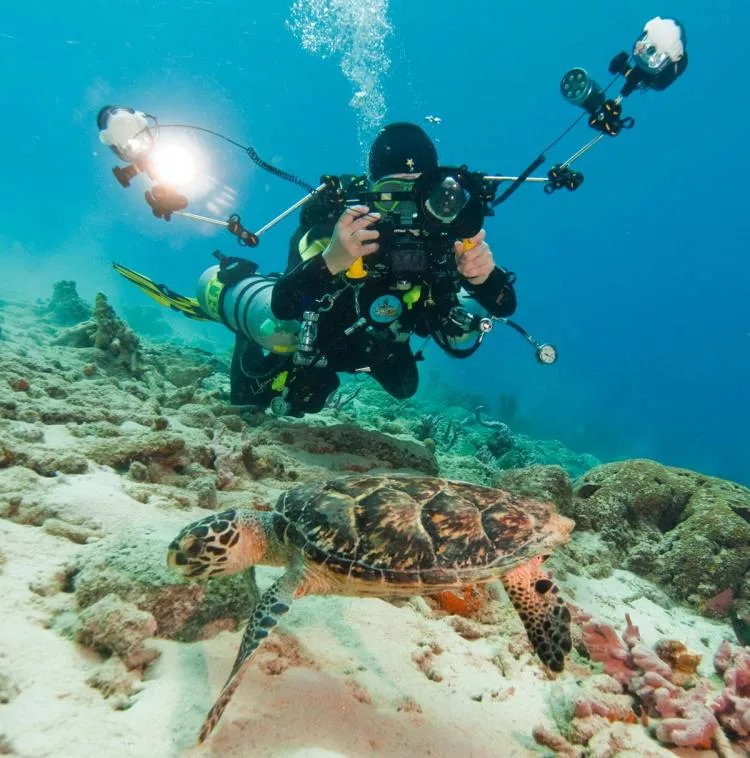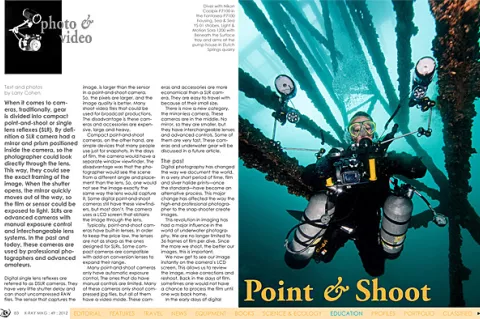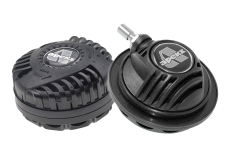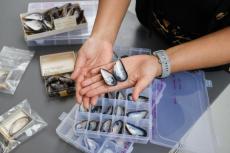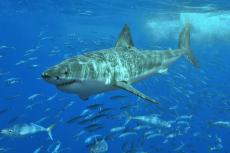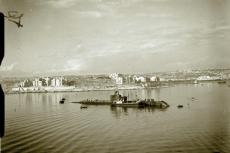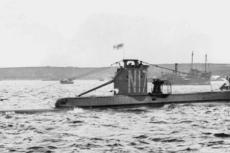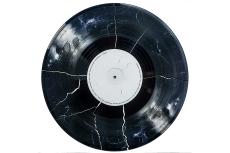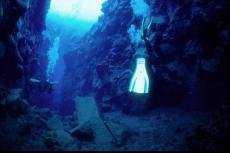When it comes to cameras, traditionally, gear is divided into compact point-and-shoot or single lens reflexes (SLR). Compact point-and-shoot cameras are simple devices that many people use just for snapshots. In order to keep the price low, the lenses are not as sharp as the ones designed for SLRs. Some compact cameras are compatible with add-on conversion lenses to expand their range.
Contributed by
When it comes to cameras, traditionally, gear is divided into compact point-and-shoot or single lens reflexes (SLR). By definition a SLR camera had a mirror and prism positioned inside the camera, so the photographer could look directly through the lens. This way, they could see the exact framing of the image. When the shutter opens, the mirror quickly moves out of the way, so the film or sensor could be exposed to light. SLRs are advanced cameras with manual exposure control and interchangeable lens systems. In the past and today, these cameras are used by professional photographers and advanced amateurs.
Digital single lens reflexes are referred to as DSLR cameras. They have very little shutter delay and can shoot uncompressed RAW files. The sensor that captures the image, is larger than the sensor in a point-and-shoot camera. So, the pixels are larger, and the image quality is better. Many shoot video files that could be used for broadcast productions. The disadvantage is these cameras and accessories are expensive, large and heavy.
Compact point-and-shoot cameras, on the other hand, are simple devices that many people use just for snapshots. In the days of film, the camera would have a separate window viewfinder. The disadvantage was that the photographer would see the scene from a different angle and placement than the lens. So, one would not see the image exactly the same way the lens would capture it. Some digital point-and-shoot cameras still have these viewfinders, but most don’t. The camera uses a LCD screen that obtains the image through the lens.
Typically, point-and-shoot cameras have built-in lenses. In order to keep the price low, the lenses are not as sharp as the ones designed for SLRs. Some compact cameras are compatible with add-on conversion lenses to expand their range.
Many point-and-shoot cameras only have automatic exposure control. The ones that do have manual controls are limited. Many of these cameras only shoot compressed jpg files, but all of them have a video mode. These cameras and accessories are more economical than a SLR camera. They are easy to travel with because of their small size.
There is now a new category, the mirror-less camera. These cameras are in the middle. No mirror, so they are smaller, but they have interchangeable lenses and advanced controls. Some of them are very fast. These cameras and underwater gear will be discussed in a future article.
The past
Digital photography has changed the way we document the world. In a very short period of time, film and silver halide prints—once the standard—have become an alternative process. This major change has affected the way the high-end professional photographer to the snap-shooter create images.
his revolution in imaging has had a major influence in the world of underwater photography. We are no longer limited to 36 frames of film per dive. Since the more we shoot, the better our images, this is important.
We now get to see our image instantly on the camera’s LCD screen. This allows us to review the image, make corrections and reshoot. Back in the days of film, sometimes one would not have a chance to process the film until one was back home.
In the early days of digital imaging, SLR cameras were large and expensive. So many photographers starting using compact, point-and-shoot cameras to do serious underwater photography. Many of these early digital cameras had professional features including manual control, hot-shoes, and could shoot RAW files. Most were also very slow.
Light & Motion made a housing for the Olympus C3030 back in 2000. This was an aluminum housing with bulkheads for the strobes and complete camera control access. In 2002, they came out with the Titan for the Olympus E-10. This was an over-sized point-and-shoot camera that did have a through-the-lens viewfinder. So technically, this was the first housing for a DSLR. Since the camera did not have interchangeable lenses, it still shared many characteristics with point-and-shoot cameras. Before this Light & Motion manufactured video housings and were primarily a producer of bicycle lighting.
Aquatica, a major producer of SLR film camera housings, started in 2000 with the Coolpix 995. This aluminum housing had dual bulkheads and shared many of the features of their film SLR housing. They produced their first DSLR housing for the Nikon D100.
Ikelite always produced reasonably priced polycarbonate housings for film SLRs. They also had low cost options for film, point-and-shoot, and even disposable cameras. They started making housings for the Nikon Coolpix 990 in 2000. These days, Ikelite manufactures housings for more camera models than any other company.
Camera manufactures including Olympus, Canon, Sony, Fujifilm, Casio and others started manufacturing their own low-cost underwater housings for simple digital cameras. This allowed any scuba diver, snorkeler or beach bum to protect their camera and produce images around and under the sea. This brought underwater imaging to the masses.
Notice that Nikon is missing from the above list. In 2002, Howard Rosenstein started Fantasea Line. Their first housing was the CP4 for the Nikon Coolpix 885 and 4300. This low-cost housing still had many features needed to do serious underwater photography. This allowed many people to be able to afford shooting with their Coolpix camera underwater. Today, Fantasea Line still produces housings for the Nikon Coolpix Line, and other reasonably priced underwater photo accessories.
The present
Today, the number of compact point-and-shoot cameras is staggering. Cheap auto-only cameras seem to dominate the market. There are still some cameras with advanced features that are suitable for underwater imaging. Nowadays, the price of DSLRs have dropped dramatically, but using a point-and-shoot camera does have some advantages.
Besides the price, point-and-shoot cameras are small and easy to travel with. Now that airlines charge us as much for our gear as our seat, size and weight does matter. Although they have limitations, the simplicity of a point-and-shoot camera does appeal to many photographers of different levels.
The principals of producing a well-crafted underwater image have not changed. The rules stay the same for film, expensive digital pro or inexpensive snapshot cameras. Let’s explore these rules and how they relate to our gear choices.
Get close
The less water between the camera lens and the subject, the better the images will be. In order to get close to the subject, one needs to have a wide-angle lens for large subjects or a macro lens for small subjects. All point-and-shoot cameras have a macro mode. Cameras with small sensors excel at small subjects. All one has to do is put the camera in macro mode (usually a flower icon) and move in close.
Published in
- Log in to post comments

